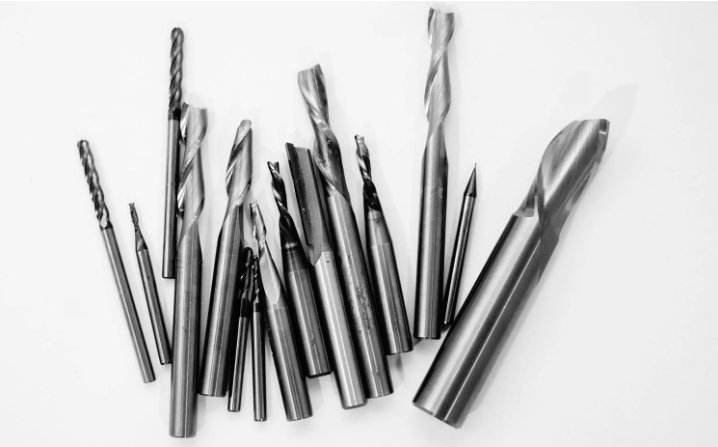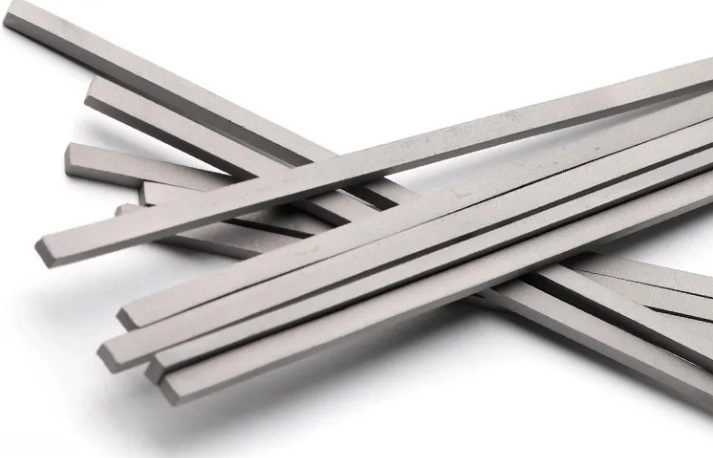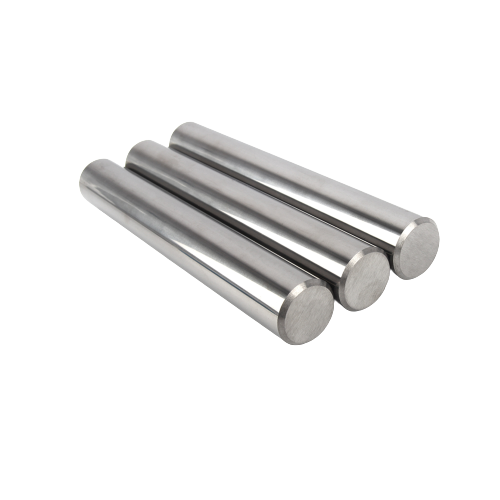초경합금 엔드 밀 는 다양한 재료를 가공할 때 탁월한 정밀도, 내구성 및 다용도성을 제공하여 현대 가공의 초석으로 자리 잡고 있습니다. 금속 매트릭스 내에 결합된 미세한 텅스텐 카바이드 입자로 구성된 절삭 날이 특징인 이 공구는 경도, 내마모성 및 내열성 면에서 이전 고속강(HSS)을 능가합니다. 이 심층 탐구에서는 초경 엔드밀의 구조, 응용 분야, 장점 및 최적의 가공 결과를 달성하기 위한 중요한 요소를 포함하여 초경 엔드밀의 복잡성에 대해 자세히 살펴봅니다.

도구 내부: 초경 엔드밀의 해부학적 구조 분해하기
구성 요소 및 구성 자세히 살펴보기
- 커팅 엣지(플루트): 엔드밀의 핵심으로, 효율적인 재료 제거를 위해 정밀한 형상으로 세심하게 연마된 여러 개의 절삭날이 특징입니다. 플루트 구성은 용도에 따라 다르며, 직선형, 나선형 또는 특수 작업에 맞춘 복잡한 형상을 포함합니다.
- Shank: 이 원통형 부품은 밀링가공기의 공구 홀더에 단단히 고정되어 작동 중 안정성과 정확한 위치 지정을 보장합니다. 일반적인 샹크 유형에는 웰던, 휘슬 노치 또는 직선 샹크가 있으며, 각기 다른 클램핑 메커니즘을 제공합니다.
- 서브스트레이트: 초경합금은 뛰어난 경도와 내마모성으로 인해 절삭 날에 가장 적합하지만, 공구 본체(기판)는 다양한 재료로 제작할 수 있습니다:
- 솔리드 카바이드: 비용이 더 들지만 까다로운 애플리케이션을 위한 최고의 강성과 성능을 제공합니다.
- 카바이드 팁 HSS: 비용 효율적인 고속 강철(HSS) 바디와 브레이징 초경 팁을 전략적으로 결합하여 성능과 경제성 사이의 균형을 맞춥니다.
- 코팅: 초경 엔드밀은 성능을 더욱 향상시키기 위해 첨단 증착 기술을 사용하여 특수 코팅 공정을 거치는 경우가 많습니다. 이러한 코팅은 보호막 역할을 하여 공구 수명을 늘리고 표면 마감을 개선하며 더 빠른 절삭 속도를 가능하게 합니다. 인기 있는 코팅 옵션은 다음과 같습니다:
- 질화 티타늄(TiN): 독특한 금색으로 즉시 알아볼 수 있는 TiN은 경도와 내마모성을 향상시킵니다.
- 티타늄 카보나이트(TiCN): 경도와 내마모성에서 TiN을 능가하는 TiCN은 종종 더 진한 회색 또는 검은색으로 나타납니다.
- 알루미늄 질화 티타늄(AlTiN): 이 코팅은 고열 환경에서 탁월한 성능을 발휘하므로 고속 가공 및 절단하기 어려운 재료 가공에 이상적인 선택입니다.
- 다이아몬드 같은 탄소(DLC): 이름에서 알 수 있듯이 DLC는 마찰이 매우 적고 내마모성이 뛰어나 복합재와 같은 마모성 소재를 가공할 때 매우 유용합니다.
다양한 옵션의 세계: 초경 엔드밀의 종류와 응용 분야 탐색하기
러프닝에서 마무리까지: 적합한 도구 선택하기
| 엔드밀 유형 | 주요 기능 | 이상적인 애플리케이션 |
|---|---|---|
| 사각 엔드밀 | - 90도 모서리가 있는 평평한 커팅 엔드<br> - 스퀘어 숄더, 슬롯, 포켓을 만들기 위한 디자인 | 범용 밀링, 슬롯 및 포켓 생성 |
| 볼 엔드 밀 | - 반구형 커팅 엔드<br> - 둥근 모서리, 윤곽선, 복잡한 3D 모양 제작에 이상적입니다. | 금형 제작, 다이 싱킹, 컨투어링, 인그레이빙 |
| 코너 반경 엔드밀 | - 특정 반경의 둥근 모서리 특징<br> - 정사각형 및 볼 엔드 밀의 속성을 결합합니다. | 모따기, 래디얼링, 표면 블렌딩, 필렛 만들기 |
| 황삭 엔드밀 | - 더 적고 깊은 플루트가 장착되어 공격적인 재료 제거가 가능합니다.<br> - 높은 금속 제거율과 신속한 재고 제거에 최적화됨 | 많은 양의 재료를 빠르게 제거하는 것이 핵심인 황삭 작업 |
| 엔드밀 마감 | - 미세한 표면 마감을 위한 더 얕은 플루트가 특징입니다.<br> - 가벼운 절삭과 엄격한 공차 유지를 위한 설계 | 매끄러운 표면과 정밀한 치수가 가장 중요한 마감 작업 |
| 하이-헬릭스 엔드밀 | - 칩 배출을 개선하기 위한 공격적인 나선형 각도가 특징입니다.<br> - 깊은 컷과 까다로운 소재에 적합 | 고속 가공, 깊은 포켓 생성, 가공하기 어려운 소재 처리 |
| 드릴 밀 | - 드릴링과 밀링 기능을 결합한 다용도 공구<br> - 구멍을 뚫을 수 있는 중앙 절삭날과 밀링을 위한 주변 절삭날이 있습니다. | 단일 툴로 드릴링 및 프로파일링을 수행하여 작업 간소화, 툴 교체 감소 |
시장 역학: 초경 절삭 공구의 거침없는 상승세
초경 엔드밀의 글로벌 시장은 몇 가지 주요 요인에 힘입어 괄목할 만한 성장을 거듭하고 있습니다:
- 자동화 혁명: CNC 가공 및 자동화의 광범위한 채택은 까다로운 생산 환경의 혹독함을 견딜 수 있는 고성능 절삭 공구를 요구합니다.
- 항공우주 및 의료 발전: 급성장하는 항공우주 및 의료 산업은 티타늄, 인코넬, 코발트-크롬 합금과 같은 경량 고강도 소재의 정밀 가공에 크게 의존하고 있으며, 초경합금이 탁월한 소재입니다.
- 소형화 트렌드: 산업 전반에 걸쳐 전자, 의료 기기 및 기타 분야에서 더 작고 복잡한 부품에 대한 수요가 증가함에 따라 초경합금이 최고로 통하는 영역인 마이크로 가공 능력에 대한 필요성이 커지고 있습니다.
TRUER: 초경 엔드밀 성능의 벤치마크 설정
비교 분석: 트루어 대 업계 리더
| 공급업체 | 위치 | 가격 범위(개당, 대략적인 가격) | 스페셜티 |
|---|---|---|---|
| TRUER | 미국 | $15 – $160+ | 타협하지 않는 품질, 애플리케이션별 설계, 경쟁력 있는 가격, 탁월한 고객 지원 |
| 샌드빅 코로만트 | 스웨덴 | $20 – $200+ | 고성능 카바이드 재종, 혁신적인 공구 설계, 지속 가능성에 초점 맞추기 |
| 케나메탈 | 미국 | $18 – $180+ | 광범위한 제품 포트폴리오, 다양한 코팅 옵션, 산업별 솔루션 |
| Iscar | 이스라엘 | $16 – $170+ | 최적화된 칩 배출을 위한 고급 형상, 고효율 가공 솔루션 |
참고: 초경 엔드밀의 가격은 엔드밀 크기, 유형, 재질, 코팅, 주문 수량 등 다양한 요소의 영향을 받습니다. 비교를 위해 항상 여러 공급업체에 견적을 요청하는 것이 좋습니다.
장점과 한계 비교하기: 정보에 입각한 가공 결정 내리기
초경합금의 장점: 장단점
| 기능 | 장점 | 제한 사항 |
|---|---|---|
| 경도 및 내마모성 | - 뛰어난 경도로 가장 단단한 소재도 가공 가능<br> - 높은 내마모성으로 공구 수명이 연장되어 시간이 지남에 따라 툴링 비용이 크게 절감됩니다. | - 깨지기 쉬워 강한 충격이나 부적절한 사용으로 인해 깨지거나 파손될 수 있습니다. |
| 절단 속도 및 이송 속도 | - HSS 공구에 비해 훨씬 빠른 절삭 속도를 제공합니다.<br> - 재료 제거율 증가는 생산성 향상과 사이클 시간 단축으로 이어집니다. | - 진동을 최소화하고 잠재적인 공구 손상을 방지하기 위해 견고한 설정과 기계가 필요합니다. |
| 정밀도 및 표면 마감 | - 매우 엄격한 공차와 미세한 표면 마감을 구현할 수 있습니다.<br> - 종종 2차 마감 작업의 필요성을 줄이거나 제거하여 귀중한 시간과 비용을 절약할 수 있습니다. | - 초기 비용은 HSS 공구보다 높을 수 있지만, 연장된 공구 수명과 우수한 성능으로 초기 투자 비용을 상쇄하는 경우가 많습니다. |
팁 그 이상: 초경 엔드밀 성능에 영향을 미치는 요소들
가공 작업 최적화: 주요 고려 사항
- 소재 호환성: 가공할 특정 소재에 따라 적절한 카바이드 재종, 코팅 및 형상을 선택하는 것은 공구 수명을 극대화하고 원하는 절삭 성능을 달성하며 원하는 표면 조도를 얻기 위해 가장 중요합니다.
- 절단 매개변수: 공구와 재료 특성을 모두 고려하여 절삭 속도, 이송 속도 및 절삭 깊이를 최적화하는 것은 효율적이고 효과적인 가공을 위해 필수적입니다. 제조업체에서 제공하는 절삭 데이터 차트를 참조하거나 전문 소프트웨어를 활용하여 정밀하게 계산하세요.
- 냉각수 선택: 적절한 절삭유 도포는 열을 제어하고 절삭 영역을 윤활하며 칩을 효율적으로 배출하는 데 중요한 역할을 합니다. 이러한 모든 요소는 공구 수명을 연장하고 표면 조도를 개선하는 데 기여합니다.
- 머신 강성: 초경 엔드밀, 특히 솔리드 카바이드 버전은 진동을 최소화하면서 단단한 기계에서 최적의 성능을 발휘합니다. 따라서 공구의 휨이나 파손이 최소화됩니다. 적절한 워크홀딩 기술과 세심한 기계 유지보수는 성공을 위해 매우 중요합니다.
왜 트루어를 선택해야 할까요?
- 품질에 대한 확고한 약속: TRUER는 최고급 초경합금 소재만을 공급하고 제조 공정의 모든 단계에서 엄격한 품질 관리 조치를 시행하여 TRUER의 이름을 단 모든 엔드밀이 최고의 업계 표준을 충족하도록 보장합니다.
- 애플리케이션별 전문성: 숙련된 엔지니어로 구성된 당사의 팀은 고객이 선택 프로세스를 탐색하고 재료, 필요한 공차 및 원하는 결과를 고려하여 고유한 가공 요구 사항에 맞는 최적의 엔드밀을 찾을 수 있도록 전문적인 지침을 제공합니다.
- 사용자 지정 기능: TRUER는 가장 까다롭고 특수한 애플리케이션 요구 사항까지 충족하는 맞춤형 엔지니어링 솔루션을 전문적으로 제작합니다. 여기에는 정확한 사양에 맞게 형상, 코팅 및 크기를 조정하는 것이 포함됩니다.
- 고객의 성공을 위해 헌신합니다: TRUER는 단순히 공구를 공급하는 데 그치지 않고 지속적인 파트너십을 구축합니다. 당사는 고객의 가공 작업이 원활하게 진행되고 최적의 결과를 얻을 수 있도록 탁월한 지원과 지속적인 기술 지원을 제공합니다.
자주 묻는 질문: 초경 엔드밀 관련 질문 해결하기
1. 초경합금 엔드밀이 고속강(HSS) 엔드밀에 비해 갖는 주요 장점은 무엇인가요?
초경 엔드밀은 HSS 엔드밀에 비해 경도, 내마모성, 내열성이 훨씬 뛰어납니다. 이는 공구 수명 연장, 절삭 속도 향상, 재료 제거율 증가, 더 단단한 재료 가공 능력 향상으로 이어집니다.
2. 초경 엔드밀에 적합한 코팅을 선택하려면 어떻게 해야 하나요?
이상적인 코팅은 용도에 따라 다릅니다. TiN은 범용 가공을 위한 다목적 코팅이며, TiCN은 연마재에 향상된 경도를 제공하고, AlTiN은 고열 응용 분야에 탁월하며, DLC는 복합재 및 기타 연마재 가공에 이상적입니다.더 자세히 알고 싶으신가요? 문의하세요 클릭.
3. 엔드밀 조기 고장의 가장 일반적인 원인은 무엇인가요?
부적절한 절삭 파라미터, 불충분한 절삭유 도포, 과도한 공구 오버행, 기계 강성 불량, 엔드밀의 능력을 초과하는 소재 가공 시도 등으로 인해 조기 고장이 발생할 수 있습니다.
4. 초경 엔드밀을 재연마하거나 재연마할 수 있습니까?
예, 초경 엔드밀은 일반적으로 여러 번 재연마하거나 재연마하여 수명을 연장하고 툴링 비용을 절감할 수 있습니다. 그러나 공구의 형상과 성능을 유지하려면 자격을 갖춘 재연삭 서비스를 이용하는 것이 중요합니다.
5. TRUER는 초경 엔드밀의 품질과 일관성을 어떻게 보장합니까?
TRUER는 최고 품질의 공구를 제공하기 위해 최선을 다하고 있습니다. 당사는 프리미엄 카바이드 소재를 공급하고 제조 공정 전반에 걸쳐 엄격한 품질 관리 조치를 시행하며 고급 검사 기술을 사용하여 모든 엔드밀이 당사의 엄격한 표준을 충족하도록 보장합니다.




